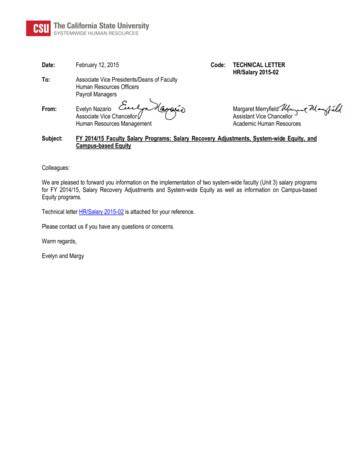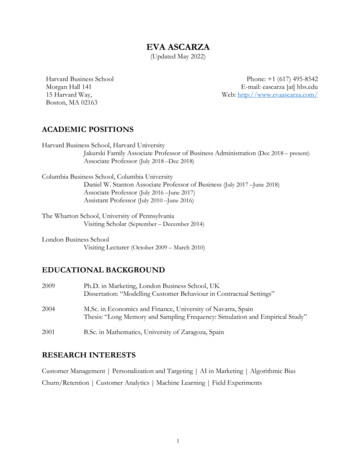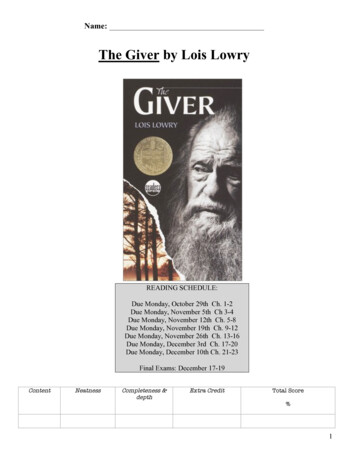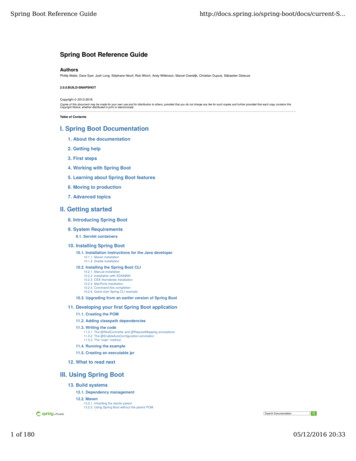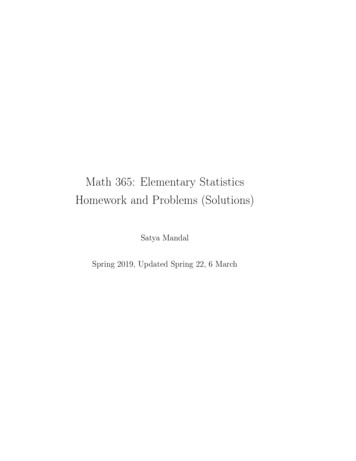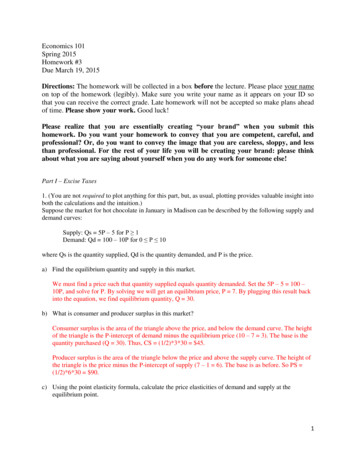
Transcription
Economics 101Spring 2015Homework #3Due March 19, 2015Directions: The homework will be collected in a box before the lecture. Please place your nameon top of the homework (legibly). Make sure you write your name as it appears on your ID sothat you can receive the correct grade. Late homework will not be accepted so make plans aheadof time. Please show your work. Good luck!Please realize that you are essentially creating “your brand” when you submit thishomework. Do you want your homework to convey that you are competent, careful, andprofessional? Or, do you want to convey the image that you are careless, sloppy, and lessthan professional. For the rest of your life you will be creating your brand: please thinkabout what you are saying about yourself when you do any work for someone else!Part I – Excise Taxes1. (You are not required to plot anything for this part, but, as usual, plotting provides valuable insight intoboth the calculations and the intuition.)Suppose the market for hot chocolate in January in Madison can be described by the following supply anddemand curves:Supply: Qs 5P – 5 for P 1Demand: Qd 100 – 10P for 0 P 10where Qs is the quantity supplied, Qd is the quantity demanded, and P is the price.a) Find the equilibrium quantity and supply in this market.We must find a price such that quantity supplied equals quantity demanded. Set the 5P – 5 100 –10P, and solve for P. By solving we will get an equilibrium price, P 7. By plugging this result backinto the equation, we find equilibrium quantity, Q 30.b) What is consumer and producer surplus in this market?Consumer surplus is the area of the triangle above the price, and below the demand curve. The heightof the triangle is the P-intercept of demand minus the equilibrium price (10 – 7 3). The base is thequantity purchased (Q 30). Thus, CS (1/2)*3*30 45.Producer surplus is the area of the triangle below the price and above the supply curve. The height ofthe triangle is the price minus the P-intercept of supply (7 – 1 6). The base is as before. So PS (1/2)*6*30 90.c) Using the point elasticity formula, calculate the price elasticities of demand and supply at theequilibrium point.1
Point elasticity of demand is (1/m)*(P/Q) , where m is the slope of the demand curve. Pointelasticity of supply is defined similarly but using the slope of the supply curve (and the absolute valueis unnecessary). Note the supply and demand equations are both presented in an ‘x-intercept’ form, sothe coefficient on P is (1/m).Using these formulae, we get:Price Elasticity of Demand (-10)*(7/30) 7/3 [Demand is elastic at this point since the elasticityvalue is greater than one]Price Elasticity of Supply 5*(7/30) 7/6 [Supply is elastic at this point since the elasticity value isgreater than one]d) Suppose February is more bitterly cold than usual, increasing demand for hot chocolate by 60 units atany given price. Supply remains as before. Given this information, what is the new equilibrium priceand quantity?Given the change, demand can now be expressed by Q 160 – 10P. So using the same practice asbefore, we set the supply equal to demand and solve for P. Thus we get equilibrium price, P 11, andquantity Q 50.e) What is the new consumer and producer surplus, CS' and PS'?The new P intercept for demand is 16. So the height of the CS' triangle is 16 – 11 5. Quantity isnow 50 so:CS' (1/2)*(5)*(50) 125The supply curve did not change, so all we have to do is take into account the new quantity and price.The height of the PS' triangle is 11 – 1 10, and the base is 50. Thus,PS' (1/2)*(10)*(50) 250f) What are the new price elasticities of supply and demand using the point elasticity formula?Price Elasticity of Demand (-10)*(11/50) 11/5 2.2Price Elasticity of Supply 5*(11/50) 11/10 1.1g) Suppose the city of Madison decides to tax hot chocolate with a 3 per unit excise tax on suppliers.Calculate the equilibrium quantity (Qet ), price (Pet ), consumer surplus (CSt ), producer surplus (PSt ),government revenue (Govt. Tax Rev.), tax incidence on consumers (CTI), tax incidence on producers(PTI), and deadweight loss (DWL) from this tax for January (before the change in demand).(A graph of the solution follows the explanation)The tax has the effect of adding a 3 per unit cost to suppliers, shifting the supply curve leftward. Theoriginal supply curve had a P-intercept of 1, so the new will have a P-intercept of 4. The slope isunchanged, so using this information we can determine that the new supply curve will be Q 5P -20.As before solve for the equilibrium price and quantity. You should find Pet 8 and Qet 20.From the plot, we can see CSt isCSt (1/2)*2*20 20Although the price is 8, producers only receive 5 after paying the tax (this is Pnet as discussed inlecture), thus Producer surplus is the triangle below 5 and above the original supply curve.2
PSt (1/2)*20*4 40The tax is 3 per unit, and 20 units were bought, thus Government Revenue isGovt. Tax Rev. 3*20 60Deadweight loss can be observed in the plot as the dark triangle in the middle.DWL (1/2)*3*10 15We can see that the DWL is not government revenue, producer surplus or consumer surplus, so it ispotential surplus that is lost due to the imposition of the excise tax.Again, from the plot, we can see that of the 3 tax, consumers effectively pay 1 per unit of the goodconsumed and producers pay 2 per unit of the good produced and sold (the upper and lower verticalheights of the government revenue rectangle respectively). So total consumer tax incidence (CTI) is 20, and producer tax incidence (PTI) is 40.h) What is the ratio of the absolute value of the slope of the demand curve to the slope of the supplycurve? What is the ratio of consumer tax incidence to producer tax incidence? Is this a coincidence?Make a conjecture about what the relationship between the two ratios. Briefly discuss an intuition forthis result.The slope of the demand curve is -1/10 and the slope of the supply curve is 1/5. Thus, the absolutevalue of the ratio of their slopes is ½. CTI is equal to 20 and PTI is equal to 40. Thus, the ratio ofCTI/PTI 1/2.3
The absolute value of the ratio of slopes will always equal the ratio of tax incidences. The intuitionfor this is as follows:If the magnitude of the slope of the demand curve is higher than that of the supply curve, we canthink of the demand as being more inelastic than supply, thus if there is a tax, producers have a betterability to pass the tax to consumers without losing too much business. Conversely, if demand is lesssteep than supply, then demand is more elastic than supply, and if producers try to pass too much ofthe tax to consumers, they will see a sharp drop in demand.i)[Note: this is a bit of a CHALLENGE QUESTION: don't despair, but do think!] Without fullysolving for it, what would be the deadweight loss if we instead used the demand curve from February(i.e. after the demand shift)? (Draw a quick sketch to see what will happen.) What does this tell youabout the relationship between deadweight loss and parallel shifts of one of the curves?Deadweight loss is unchanged. If we draw a quick sketch, we would see that by shifting the demandcurve out parallel to the original, we simply slide the deadweight loss triangle along the supply curveuntil it fits between the curves at the new equilibrium point. From this, we can conclude that parallelshifts don’t affect the magnitude of the DWL.Part II – International Trade2. Suppose Narnia is a small country with a domestic supply and demand for Turkish Delight given by:Domestic demand: P 10 – (1/500)QdDomestic supply: P 2 (1/500)Qswhere P is the price, Qd is the quantity demanded domestically, and Qs is the quantity supplieddomestically.a) Suppose Narnia is currently in autarky (i.e. it does not participate in the international market forTurkish Delight-Narnia's economy is a closed economy when it comes to Turkish Delight), what isthe market clearing price and quantity in the domestic market? What is Consumer, Producer, andTotal Surplus?To find the equilibrium point, follow the usual method: set supply equal to demand.10 – (1/500)Q 2 (1/500)QSolving, we find Q 2000. Plugging this back into either supply or demand, we find P 6.Consumer surplus is the triangle below the demand curve but above the equilibrium price. The Pintercept of demand is 10 and the equilibrium price is 6, so the height of the triangle is 4. The baselength is simply the equilibrium quantity. Thus,CS (1/2)*4*2000 4000To find producer surplus, we can follow a similar method to find the area of the triangle belowequilibrium price but above the supply curve. Notice, in this specific instance where the absolutevalue of the slopes of the two curves are the same, and the distance from the equilibrium price to theP-intercept is the same, we can appeal to symmetry to see PS is the same as CS. Thus,PS (1/2)*4*2000 4000Total surplus is merely the sum of the two so,4
TS 4000 4000 8000b) Narnia now decides to enter the international market for Turkish Delight. Once the market clears, wefind that Narnia is importing 2000 units of Turkish Delight. Given this fact, what must the worldprice? What is the new Consumer, Producer, and Total Surplus? Illustrate your answers graphically.We know imports are 2000. This implies that the domestic quantity demanded, Qd, is 2000 more thanthe domestic quantity supplied, Qs, i.e.,Qd Qs 2000Further by rearranging the equations for domestic supply and demand, we findQd 5000 – 500PQs 500P -1000So by substituting these two equations into the one above, we get(5000 – 500P) (500P – 1000) 2000Simplifying we get1000P 4000Thus, the world price must be P 4.To find Consumer and Producer surpluses, we proceed as before, but now CS is a much largertriangle and PS a smaller one (see plot below).CS (1/2)*6*3000 9000PS (1/2)*2*1000 1000TS 9000 1000 10,000Notice, that although PS is much smaller, the increase in CS is much greater than the loss, so TSincreases.c) Suppose Aslan, ruler of Narnia, fearing that the domestic Turkish Delight industry is unduly sufferingfrom the influx of cheap foreign Turkish Delight, decides to implement a 1 per unit tariff on imports.What is the new price for Turkish Delight in the domestic market, the quantity consumed, thequantity imported, Consumer Surplus, Producer Surplus, Government Revenue, Total Surplus5
(recalling the convention that we include Government Revenue in Total Surplus), and DeadweightLoss? Illustrate your answers graphically.Since the tariff is 1, the domestic price will be 1 more than the world price, thus P 5.Plugging this into the demand curve, we find quantity consumed is 2500. By plugging P 5 into thesupply curve, we find the 1500 units are provided by domestic producers, thus 1000 units areimported.We can calculate Consumer Surplus and Producer Surplus in the usual manner, findingCS (1/2)*5*2500 6250PS (1/2)*3*1500 2250Since the tariff is 1 per unit imported, and 1000 units are imported we know Government Revenuemust beGovt. Tax Rev. 1*1000 1000Total Surplus is CS PS GR soTS 6250 2250 1000 9500Deadweight Loss is the difference between the TS without the tariff and with the tariff, thusDWL 10,000 – 9500 500Alternatively, DWL is the area of the two black triangles in the plot, each of which has a base of 500,and height of 1, soDWL 2*( (1/2)*(500*1 ) 500d) Provide an intuitive explanation for the sources of deadweight loss under this tariff.From the plot, we can see there are two deadweight loss triangles. The one on the right (under thedemand curve) can be thought of as deadweight loss from some consumption being lost due to thetariff. The one on the left (under the supply curve) can be thought of as loss from the reallocation ofproductive resources. In the absence of the tariff, the only domestic production was by firms whocould produce more efficiently than the firms on the international market. The remaining firms wouldhave then put the unused resources towards production of a good for which they had a comparativeadvantage against the rest of the world. With the implementation of the tariff, some domesticresources that could have been better used elsewhere are now required for the production of TurkishDelight. To illustrate the point further, imagine Wisconsin put some limit on oranges imported from6
Florida. Wisconsin could make up for some of the lost imports by growing oranges domestically inheated greenhouses, but that would come at great costs.e) Suppose, Aslan, seeing the success of this tariff at generating revenue for his government decides toincrease the tariff to 3 per unit in the hope of raising even more revenue. What is the new quantityconsumed domestically, quantity imported, Consumer Surplus, Producer Surplus, GovernmentRevenue, Total Surplus, and Deadweight Loss? Illustrate your answers graphically.If the tariff is 3, then the world price plus the tariff is 7, but recall, that in autarky, the domesticprice was 6. So, given this, no units will be imported since the domestic price would have to be atleast 7 for it to be worth importing. Thus all answers are the same as from part (b).Since no units are imported, government revenue is zero.To find DWL, we can use the fact that TS without any tariff was 10,000 and TS surplus with thetariff is 8000 (the same as TS in autarky), so DWL is 2000.Alternatively we can find the area of the DWL triangle in the plot, which will give the same result.f) Suppose Aslan decides to try an alternative policy. Instead of a tariff, he decides to set an importquota. If Aslan wants Producers to receive as much surplus under this new quota as they do with the 1 tariff, what should he set the quota at? Suppose he decides to auction the import rights to a singlefirm. At most how much would a firm be willing to pay for the import license?To maintain producer surplus at the level of the 1 tariff, the price and quantities must remainunchanged. Since 1000 units were imported with the 1 tariff, that must be where the quota is set.With a quota of 1000 imported units, we know that the domestic price will be 5, since it must be thesame as the price with the 1 tariff.The license-holder gets to purchase Turkish Delight on the international market for 4 per unit andsell it in the domestic market for 5 per unit, netting 1 per unit. Thus revenue to the license holderwill be 1000*1 1000 (the same as government revenue with the tariff). A license-holder is notgoing to purchase the license if it costs more than the 1000 they would earn from it. Thus 1000 isthe upper limit to the cost of the license.g) [Note: this is a CHALLENGE QUESTION! You can get there through reasoning or through amathematical analysis-I would recommend using your comparative advantage when selecting the type7
of analysis you choose to use.] Aslan quickly realized that increasing the tariff to 3 was a bad idea ifhe was concerned about revenue; however, he is still interested in finding the tariff that maximizesrevenue. Find the revenue maximizing tariff. Can he do better than the 1 tariff? Provide someintuition for the relationship between revenue and tariff.Hint: Let T denote the tariff, then use the following facts:Imports Qd – QsPrice world price T0 T 2Think of Imports like a demand curve, but with T instead of P. At what price is revenue maximized ona linear demand curve? Think in terms of elasticity.)First we need to find as expression for imports. We know that Imports Qd – Qs. Recall,Qd 5000 – 500PQs 500P – 1000Further P 4 T so,Qd 5000 – 500(4 T) 3000 – 500TQs 500(4 T) – 1000 1000 500TWhich implies:Imports 3000 – 500T – (1000 500T) 3000 – 500T – 1000 – 500T 2000 – 1000TSo now if we think of this like a linear demand curve, we know revenue will be maximized when theprice elasticity of demand (or really a “tariff elasticity of imports” in this case) is equal to 1.So recall our formula for price elasticity of demande 1/m *(P/Q)So in our application, this converts toe 1/m *(T/Imports)Imports 2000 – 1000T is a x-intercept form, so 1000 1/m , thuse 1000 * ( T/(2000 – 1000T) )Now, we want e 1 so1 1000 * ( T/(2000 – 1000T) )2000 – 1000T 1000T2000 2000TT 1(Alternatively, we could have just used the fact that the unit elastic point is the half-way point, andjust jumped straight to the answer.)If we plot Revenue T*Imports, we should get a parabola that hits the horizontal axis at T 0 and T 2, and is above the axis between those two points. These two points make sense because, if T 0,clearly the government will raise no revenue regardless of how much is imported, and if T 2, nounits are imported, so revenue will be zero there as well.For intuition, as you increase the tariff from zero, imports are relatively inelastic, so a 1% change intariffs causes a less than 1% fall in imports, so the price effect dominates the quantity effect, andrevenues increase. Once you pass 1, the demand for imports becomes more elastic, so a 1% changein tariffs causes a more than 1% fall in imports, so the quantity effect dominates, revenue falls.8
3. Somelandia is a small nation with domestic supply and demand for widgets given byDomestic Demand: Qd 300 – 6P for 0 P 50Domestic Supply: Qs 2P – 20 for P 10where Q is the quantity demanded domestically, Qs is the quantity supplied domestically, and P is theprice.Suppose the World Price for the good is 20.a) What is the equilibrium price and quantity in autarky (remember "autarky" is the term used todescribe a closed market)?Follow the usual procedure. Set supply equal to demand:300 – 6P 2P – 20So P 40. Plugging this back into supply or demand, we find Q 60.b) What is the equilibrium price, quantity, imports, consumer and producer surplus if this market isclosed to trade? How much is the gain in surplus from international trade if this market is opened totrade? Illustrate your answers graphically. Specifically mark which region represents the surplus gainsfrom trade.From part (a) we know the market price without trade is 40 which is above the world price, thus theprice with trade will be the world price of 20.Plugging this into the supply and demand curves we findQd 180Qs 20Since the domestic quantity demanded is 180, and the domestic quantity supplied is only 20, thedifference must be made up by imports. ThusImports 160Consumer Surplus is the triangle above the world price, below the demand curve, soCS (1/2)*30*180 2700Producer Surplus is the area below world price, above the supply curve, soPS (1/2)*10*20 100Notice, without international trade, total surplus would be the triangle to the left of the domesticequilibrium, above 10 and below 50. Thus, from the plot, we can see that the gains from trade can9
be represented by the triangle below the domestic equilibrium point and above the world price,between the supply and demand curves. SoGains from Trade (1/2)*20*160 1600c) Now suppose the government decides to set an import quota of 200 widgets; i.e. only 200 widgetsmay be imported. What is the new equilibrium price, quantity, revenue to import license-holders, anddeadweight loss?From part (b) we know only 160 units would be imported in the absence of regulation. Thus, if thegovernment limits imports to 200 units, the policy has no effect. So price, quantity, imports, andsurpluses are all as they were in (b) when the market was open to trade.Since the policy has no effect, there is no revenue to those who hold the import license (licenseholders import the good at the world price and sell it at the world price for a net gain of zero).Similarly, there is no deadweight loss since the outcome is the same as the unregulated one.d) Now suppose the government of Somelandia decides to try a quota of 80 units. What will be the newequilibrium price and quantity, Consumer and Producer Surplus, Revenue to license-holders, andDeadweight Loss? Illustrate your answers graphically.First we find the equilibrium price with the quota noting the fact that, at the equilibrium priceQd Qs Quota300 – 6P (2P – 20) 80300 – 6P 2P 60Solving for P we find P 30.By plugging 30 into the demand curve, we find the quantity consumed domestically is 120 units. 80are imported (up to quota), so domestic supply is 40 units.Consumer Surplus is the usual triangle (see plot) soCS (1/2)*120*20 1200Similarly for Producer Surplus10
PS (1/2)*40*20 400License holder revenue is the number of imported units (the quota) times the difference between thedomestic price and the world price (the importer buys widgets for the world price and sells for thedomestic price, netting the difference).License Holder Rev 80*10 800Total surplus is the sum of CS, PS, and License-Holder Revenue soTS 2400Recalling that TS before the quota was 2800, we see that DWL must be 400.Alternatively, we could calculate the area of the DWL triangles from the plot.DWL (1/2)*20*10 (1/2)*60*10 100 300 400Part III – Elasticities4. Suppose the demand for gadgets is given by the following equation where P is the price and Q is thequantity demanded:P 50 – Qa) Suppose the price is originally 10 and increases to 20. Using the regular or standard percentageformula, find the price elasticity of demand for gadgets.Regular percentage elasticity of demand formula ise (% change Q / % change P) ((new Q – old Q) / old Q) / ((new P – old P) / old P) ((30 – 40) / 40) / (20 – 10) / 10) 1/4b) Suppose the price is originally 20 and decreases to 10. Using the regular percentage formula, findthe price elasticity of demand for gadgets.Using the formula again we finde ((40 – 30) / 30) / (10 – 20) / 20) (1/3) / (1/2) 2/3c) Now using the arc formula, calculate the price elasticity of demand using the prices from the previous2 parts. What is the advantage of using the arc formula over the regular percentage formulas?The arc formula is11
𝑒 (𝑄1 𝑄2 )/(𝑄1 𝑄2 ) (𝑃1 𝑃2 )/(𝑃1 𝑃2 )Thus we finde (10/70) / (10/30) 3/7We can see that the arc elasticity is between the regular elasticities from (a) and (b), and the arcelasticity measure does not depend on the ordering of the price change.d) Using the point formula, calculate the price elasticity of demand at a price of 15.The point elasticity formula ise (1/m)(P/Q) Notice the equation is given in a y-intercept form, so the slope is simply the coefficient on Q, thus m -1. Soe -1 * (15/35) 3/7e) Alice is the sole producer of gadgets, and thus gets to set the price. If Alice’s sole concern ismaximizing revenue, what price should she set?Revenue is maximized when the demand is unit elastic. We can use the fact that a linear demandcurve is unit elastic at its midpoint, implying that revenue maximizing price is 25.Alternatively, we could solve for the point algebraically1 -1 * (P/(50-P)) 1 P/(50-P)50 – P P50 2PP 255. Suppose the demand for frozen chicken nuggets and fresh tuna are given by the following equationswhere Pn is the price of nuggets (in dollars), Pt is the price of tuna (in dollars), I is median income (in tensof thousands of dollars), and Q is the quantity demanded:Demand for Frozen Nuggets: Q 20 – 2Pn – Pt – IDemand for Fresh Tuna: Q 40 – 4Pt - Pn 2Ia) Suppose the price for frozen nuggets is fixed at 2 and the price of tuna is fixed at 4. What is thequantity of frozen nuggets demanded when median income is 10,000? How about when income is 20,000? Given these quantities and using the arc formula, what is the income elasticity of demandfor frozen nuggets between these two income levels?First by plugging in the values of the fixed prices, we find Q 12 – I. By plugging in 1 and 2 forincomes we find quantities are 11 and 10 respectively.So using the arc formula (note we only use absolute value for price elasticity) from above, we gete ((11 – 10) / (11 10)) / ((1 – 2) / (1 2)) (1/21) / (- 1/3) - 1/712
b) Suppose the prices for nuggets and tuna are still fixed as they were in part (a). What is the quantity offresh tuna demanded when median income is 10,000? How about 20,000? Given these quantitiesand using the arc formula, what is the income elasticity of demand for fresh tuna?By plugging in the givens as before we find Q 22 2I. Plugging in 1 and 2 for incomes, we findquantities 4 and 6 respectively.So using the arc formula we gete ((26 – 24) / (26 24)) / ((2 – 1) / (1 2)) (2/50) / (1/3) 3/25c) Given your answers to parts (a) and (b), what can you say about Chicken Nuggets and Fresh Tuna?Are they inferior goods, normal goods and/or luxury goods?Income elasticity for frozen nuggets is negative so nuggets are an inferior good. Income elasticity fortuna is positive, but less than 1 so it is a normal, but not a luxury, good.d) Now fix the median income at 20,000 and the price of nuggets at 2. If the price of tuna is 4, whatis quantity of nuggets demanded? What if the price of tuna is 6? Using this information and the arcformula, calculate the cross-price elasticity of demand for nuggets.Plugging in the given values, we get Q 14 – Pt. Plugging in 4 and 6 for price of tuna, we getquantities 10 and 8 respectively.So using the arc formula to calculate the cross-price elasticity of demand:e ((10 – 8) / (10 8)) / ((4 – 6) / (4 6)) (2/18) / (- 2/10) - 5/9e) Given your answer to part (d), what can you say about the relationship of tuna to nuggets? Are thesubstitutes or complements?Since cross-price elasticity is negative, tuna and chicken nuggets are complements for this economy.Part IV – Consumer Theory6. Use the following information in answering this next set of questions.Sue likes to eat cheese curds and make long-distance phone calls. Currently, she has no cell phone,and must use a pay phone to make calls, thus she must pay for each call separately at a cost of 5 percall. A dish of Cheese Curds costs 10. Sue’s income is 50.a) Supposing long-distance phone calls and cheese curds are the only goods Sue buys, plot her budgetline with cheese curds on the horizontal axis, and long-distance phone calls on the vertical axis. Whatis the equation of this line? Use P as the symbol for "phone calls" and C as the symbol for "cheesecurds". Label this budget line as BL1 or "budget line part (a)".Sue’s budget can be expressed by5P 10C 50So by rearranging, terms (remember, P is the vertical axis)P 10 – 2C13
The graphs are shown in part (c).b) Suppose Sue’s income increases to 100. Plot her new budget line. What is the equation of this newbudget line? In your graph, label this budget line as BL2 or "budget line part (b)".Now Sue’s budget line can be expressed by:5P 10C 100So rearranging terms:P 20 – 2Cc) Suppose Sue’s income is still 100, but now, due to an unfortunate dairy shortage, the price of cheesecurds doubles to 20 a dish. Plot this new budget line. In your graph, label this budget line as BL3 or"budget line part (c)". What is the equation of the budget line?Now Sue’s budget line can be expressed by5P 20C 100So rearranging termsP 20 – 4Cd) [Note: (d) and (e) of this problem is a bit of a CHALLENGE and a logic puzzle: do not despair-youcan do this, and to get full credit on the homework you CANNOT avoid these challenge questions. SoSTART EARLY AND THINK SERIOUSLY!] Let’s suppose the dairy shortage has been resolved, sothe price of cheese curds is back to normal (i.e. Sue’s budget line is as in part b). A cell phoneprovider offers Sue a service plan that costs 50. For the 50, Sue gets 10 long-distance calls to start.After the first 10, Sue may pay for additional long-distance calls at a price of 1 per call. Plot thebudget line Sue would face if she paid for the service plan. (Hint: First, subtract 50 from Sue’sincome to account for the cost of the plan. Be careful; there will be a kink in the budget line.)First consider how many dishes of Cheese Curds Sue could buy if she spent all her remaining incomeon curds; this will be the x-intercept. Sue has 50 left to spend, and curds cost 10 per dish, so the xintercept is 5.Now, even if she spends all her remaining income on curds, she gets 10 calls as part of the phoneplan, so there will be a vertical line up to P 10. After the tenth phone call, Sue can pay 1 per call topurchase additional calls. If she spends all of her income on phone calls, she can afford to buy 50additional phone calls, after the first 10, so the y-intercept is 60.14
e) Suppose if Sue does not buy the phone service plan, she would consume 8 dishes of cheese curds and4 long distance phone calls (call this bundle A). If she purchases the phone plan, she would consumethe 5 cheese dishes of cheese curds and use her 10 starter calls, but no more (call this bundle B).Should she purchase the phone plan? Provide some intuition for your solution.(Hint: Sue can afford Bundle A if she doesn’t purchase the service plan since that’s what sheconsumes, and similarly, she can afford Bundle B if she purchases the service plan. But could Suehave afforded Bundle A with the service plan, and could she afford Bundle B without the serviceplan?)Note, if Sue doesn’t purchase the service plan, she could have afforded the Bundle B anyways, butshe chose to consume Bundle A anyways. If she purchases the service plan, she can no longer affordBundle A.If Sue purchases the phone plan, it must be because she prefers Bundle B to Bundle A, but she couldhave afforded B without the phone plan when she decided to consume bundle A instead of bundle B.Since she chose A over B, it must be that she prefers A to B. Thus, she would not want to purchasethe phone plan.7. Use the following information to answer this next set of questions.Suppose B
original supply curve had a P-intercept of 1, so the new will have a P-intercept of 4. The slope is unchanged, so using this information we can determine that the new supply curve will be Q 5P -20. As before solve for the equilibrium price and quantity. You should find Pet 8 and Qet 20. From the plot, we can see CSt is CSt (1/2)*2*20 .




